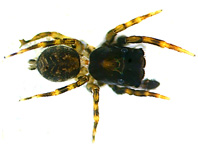Abstract
A recent phylogenetic analysis of the subfamily Ceratocanthinae (Coleoptera: Scarabaeoidea: Hybosoridae) (Ballerio & Grebennikov 2016) allowed the senior author to re-evaluate the generic placement of Ceratocanthus emarginatus Poinar, 2014, a species recently described from Dominican amber (Poinar 2014). The holotype lacks the enrollment coaptations (see Ballerio & Grebennikov 2016) and the flattened mesotibiae and metatibiae typical of members of the genus Ceratocanthus White, 1842 but has character states found in many species of the genus Germarostes Paulian, 1982. These features are a large, dorsal ocular area with incomplete genal canthus; mesotibiae and metatibiae less flattened than in Ceratocanthus; apical portion of mesotibiae bent inwards; and metatibiae with a distinct apical corbel (see Fig. 1 for ventral view of the holotype). Based on the above, Germarostes emarginatus (Poinar, 2014) new combination is proposed. All of the characters listed above are typical for the species of Germarostes assigned to the subgenus Haroldostes Paulian, 1982. However we hesitate to follow the current view of dividing the genus Germarostes into two subgenera, i.e., Germarostes and Haroldostes (Ocampo & Ballerio 2006), since the distinction between these subgenera is not well defined, as is indicated in the phylogenetic analysis (Ballerio & Grebennikov 2016). Germarostes emarginatus resembles some extant Central American Germarostes species that also have a similar dentate apical portion of the clypeus such as G. farri (Howden, 1970) from Jamaica, G. pecki (Howden, 1970) from Jamaica, G. bidens (Bates, 1887) from Panama and Brazil, G. sinuatus (Bates, 1887) from Central America, and G. nasutus (Bates, 1887) from Mexico.
References
Ballerio, A. (2014) Introduction aux Ceratocanthinae de Guyane (Coleoptera, Scarabaeoidea, Hybosoridae). In: Touroult, J. (Ed.), Contribution à l’étude des Coléoptères de Guyane - Tome VIII. Supplément au Bulletin de liaison d’ACOREP-France «Le Coléoptériste», 8, 81–85.
Ballerio, A. & Grebennikov, V.V. (2016) Rolling into a ball: phylogeny of the Ceratocanthinae (Coleoptera: Hybosoridae) inferred from adult morphology and single origin of an unique body enrollment coaptation in terrestrial arthropods. Arthropod Systematics and Phylogeny, 74, 23–52.
Grebennikov,V.V., Ballerio, A., Ocampo, F.C.& Scholtz, C.H.(2004) Larvae of Ceratocanthidae and Hybosoridae (Coleoptera: Scarabaeoidea): study of morphology, phylogenetic analysis and evidence of paraphyly of Hybosoridae. Systematic Entomology, 29, 524–543.
https://doi.org/10.1111/j.0307-6970.2004.00257.xGrimaldi, D.A. & Engel, M.S. (2005) Evolution of the Insects. Cambridge University Press, New York, New York, 755 pp.
Krell, F.-T. (2006) Fossil record and evolution of Scarabaeoidea (Coleoptera: Polyphaga). Coleopterists Society Monograph, 5, 120–143.
Ocampo, F.C. & Ballerio, A. (2006) Phylogenetic analysis of the scarab family Hybosoridae and monographic revision of the New World subfamily Anaidinae (Coleoptera: Scarabaeoidea). 4. Catalog of the subfamilies Anaidinae, Ceratocanthinae, Hybosorinae, Liparochrinae, and Pachyplectrinae (Scarabaeoidea: Hybosoridae). Bulletin of the University of Nebraska State Museum, 19, 178–209.
Poinar, G. (2014) A sphere-forming scarab beetle (Ceratocanthinae: Hybosoridae) in Dominican amber. Historical Biology, 28, 433–437.
https://doi.org/10.1080/08912963.2014.985668

